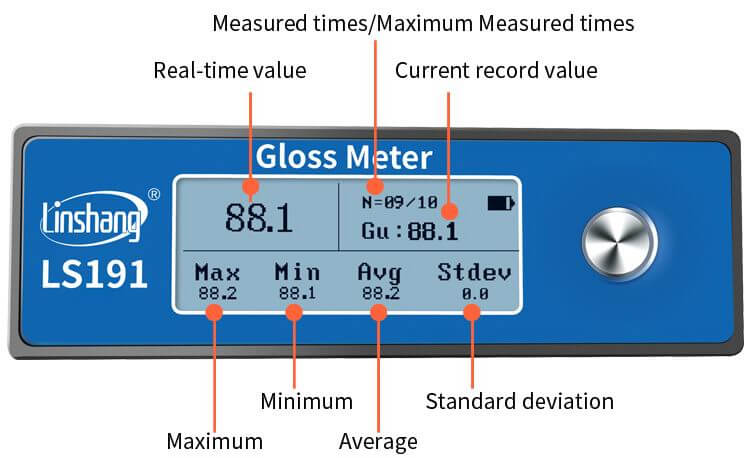Gloss Tester Measurement Data
1. Measurement data of gloss tester
Glossmeter is an instrument used to measure the glossiness of the object surface. It is widely used in automobiles, ceramics, paints, coatings, building materials and other industries. Gloss can be divided into different types of low gloss, medium gloss and high gloss according to the measurement angle. However, during the gloss tester operation, many people still do not understand the meaning of the specific value measured by the gloss tester. We will give a detailed explanation in this article.
As the surface characteristics of an object, gloss depends on the specular reflection ability of the surface to light. The so-called specular reflection refers to the reflection phenomenon where the angle of reflection is equal to the angle of incidence. Glossiness is a physical quantity that evaluates the ability of a material's surface to reflect light under a set of geometrically specified conditions. Specular gloss is a relative measure of specular gloss. The reference standard is black glass with a refractive index np = 1.567. Assuming that its plane is ideally polished, the plane reflects the natural light beam specularly and the gloss value at this time is defined as 100.0 gloss units. Glossiness is the ability of the surface to reflect light when the object is irradiated with light. It is usually expressed by the reflectivity of the sample relative to the standard surface in the specular (normal reflection) direction multiplied by 100, that is G = 100R / R. R in the formula—reflectivity of the sample surface, / R—reflectivity of the standard plate. Taking polished black glass as a reference standard plate, the refractive index of sodium D rays is 1.568. The specular gloss for each geometric optical condition is scaled to 105 gloss units.
In simple terms, the value measured by the gloss tester is actually the ratio of the reflection on the object surface divided by the reflectance of the standard plate. The larger the ratio, the higher the gloss. The smaller the ratio, the lower the gloss.
2. What does the small gloss value mean?
In fact, the larger the ratio above, the higher the gloss and the smaller the ratio, the lower the gloss. There is also a prerequisite for measuring angle. Simply understanding the value of the gloss tester is not very meaningful, we need to consider a variety of factors. When the gloss tester is used for measurement, the greater the selected incident angle, the greater the specular reflectance and the higher the gloss. Conversely, the smaller the incident angle, the lower the specular reflectance and the lower the gloss .

Therefore, when expressing the value of the gloss tester, we must first explain the selected angle of incidence in order to compare whether the tester object gloss is qualified. Generally speaking, 20-degree gloss tester is recommended for high gloss items and 85-degree gloss tester is recommended for low gloss items.
3. What is gloss unit?
In fact, there is no unit for gloss. Usually people say how many GU, but that is not the unit of gloss. Glossiness can be said to be a set of geometrically specified conditions to reflect light on the surface of the material. The physical quantity to be evaluated can be expressed as a% or a number.
4. Technical characteristics of LS191 gloss tester
The LS191 gloss testeris measured in real time and the data can be displayed on the interface immediaterly.
The LS191 gloss tester has ambient temperature compensation function, stable values and there is no need to calibrate the gloss tester every time it is turned on.
The national first-class machine standard ensures that it passes the inspection of any Chinese authoritative measurement agency.
Intelligent statistics function, the gloss tester can automatically count the number of measurements, and automatically calculate the maximum value, minimum value, average value and standard deviation value in the test data. This function can easily and quickly analyze the uniformity of glossiness in different positions of a material.
Aviation aluminum shell and base, super good texture; small design, easy to carry.
Built-in rechargeable lithium battery, ultra-low power consumption.
LS191 gloss testersupports USB transmission, special operation software. It can be connected to the computer and generate the test report.